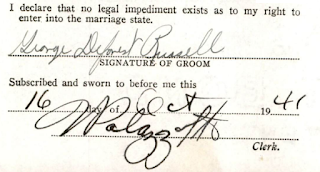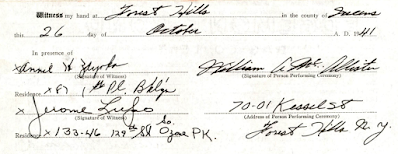In an effort to find out what became of Baby Boy Lutter, born May 9, 1916 in Newark, New Jersey, I looked up a death certificate for Richard Quackenbush.
An index of deaths in New Jersey can be found through Reclaim the Records or Ancestry. In spite of the name of this database at Ancestry ("New Jersey, U.S., Death Index 1848-1878, 1901-2017"), there are no indexes for the years 1904-1915 and 1930-1948.
 |
| Index of Deaths in New Jersey Richard Quackenbash died December 1916 in Newark |
I have all of the Lutter death certificates through 1965. Baby Boy born 1916 is not among them. Although Baby Boy was born with the surname Lutter, his parents were not married. His death certificate may be under his mother's surname- Quackenbush.
This is why I wanted to view the 1916 death certificate for Richard Quackenbush.
I was on the right track; however, this is another child created by my great grandfather and Margaret. This child was born June 30, 1914 in Newark- according to his death certificate.
This was unexpected.
I have all of the Lutter birth certificates through 1924. How did I miss this Lutter baby born in 1914?
An index of births is available online through Reclaim the Records and Ancestry. Nothing matched this birthdate in the year 1914 in Newark under the surname Lutter or Quackenbush. Next I searched by the exact date. SUTTER. The surname was misinterpreted in the index as Sutter instead of Lutter.
 |
| Birth index New Jersey at Ancestry This is an index of the index. The certificates are on microfilm at the Archives in Trenton, New Jersey. |
 |
| Sutter born June 30, 1914 in Newark. This is Ancestry's index of the New Jersey geographic birth index. |
 |
| Image of the geographic birth index. Sutter, baby of H. and M., born June 30, 1914 in Newark, New Jersey. |
 |
| Birth certificate of Baby Lutter, indexed Sutter. June 30, 1914 at Newark City Hospital, Newark, Essex County, New Jersey. Father- Howard Lutter, age 27, occupation brakeman. Mother- Margaret Quackenbush, age 18. |
Baby Lutter/Sutter became Richard Quackenbush. Two year old Richard was buried in Evergreen Cemetery. This cemetery lies in three cities- Newark, Elizabeth, and Hillside, New Jersey. I called the cemetery office for the location of this grave and was told that he was buried in the baby section. These are tiny, single plots, usually with no markers.
Another avenue to pursue is the funeral home or undertaker. James M Vaughan was a lesser-known undertaker. I do not know what became of his business and those records. He died in 1954 and was buried at Holy Sepulchre Cemetery in East Orange.
I have not found baby Richard in the 1915 New Jersey State census.
I reviewed what I had uncovered about the life of Howard Lutter.
Howard Lutter and Ethel Laurel Winterton married in Newark on September 17, 1910. The first child of this marriage was my grandfather, Clifford Lutter, born in Philadelphia, Pennsylvania on March 18, 1915.
Howard had already made a son, Richard, with Margaret the year before Clifford was born.
The next year, 1916, Howard and Margaret had twins. The female twin died. Then Richard, age two and a half, died.
In 1918, Beryl, the second and final child of Howard and Ethel, was born in Newark.
Howard divorced Ethel in 1927. He narrated the movements of the family in the 1910s. He failed to mention the children he made with another women that overlapped the birth of the children of this marriage.
 |
| Responses of Howard Lutter in his divorce action against Ethel Laurel Winterton, 1926 |















































